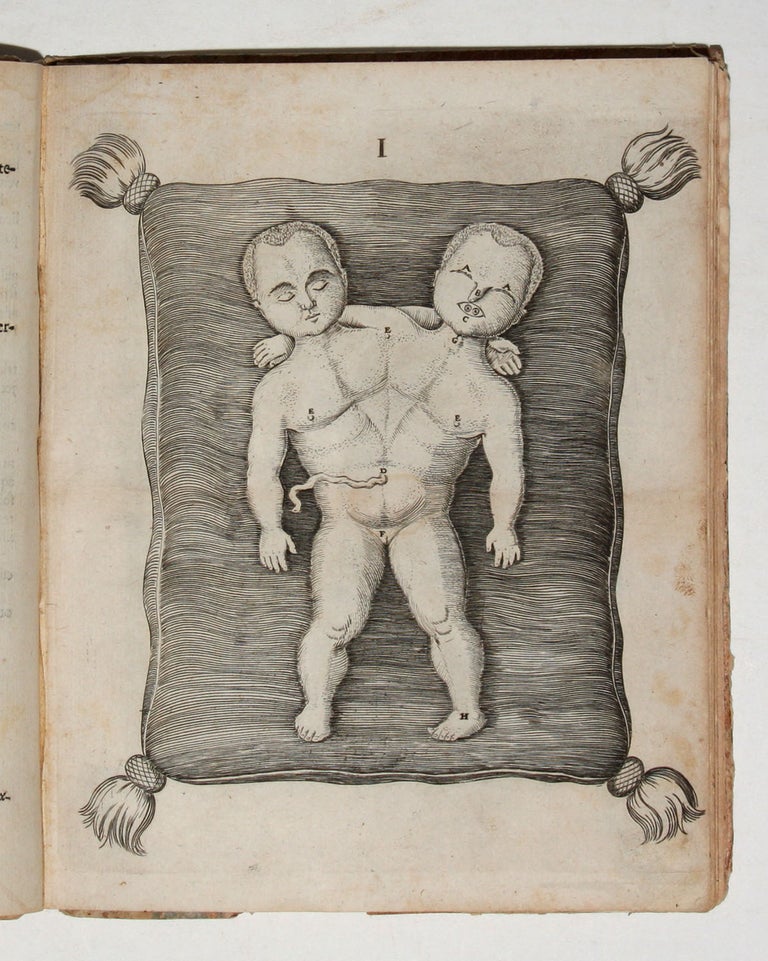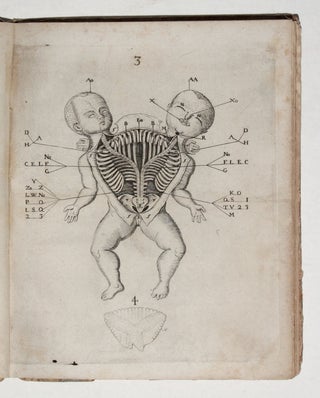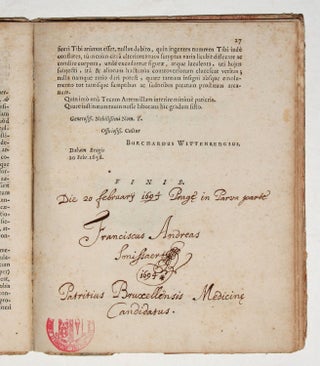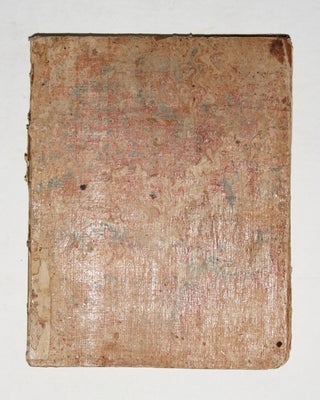Specimina Anatomica, cum clarriss. Doctissimorumque Virorum Epistolis aliquot & Testimoniis.
14ff. 4to. [19.8 x 15.5], 27 pp., with four engravings.
[Bound with:]___ Epistolica Dissertatio, Rotterdam, Joannis Naerani, 1659. 6 pp., with one engraving.
[Bound with:]___ Epistola Apologetica. Rotterdam, Arnoldus Leers, 1661. 10 pp.
[Bound with:]___ Omnibus verae Anatome Studiosis. Rotterdam, Joannem Naeranum, 1660. 4 pp.
[And with:] MAJOR, Johannis. Historia Anatomica Calculorum. Lipsius, Johan-Ericus Hahnius, 1663. [26] pp., engraved vignette on title.
Marbled paper over thin pine boards with some cracking, and a worm hole in the back continuing through Major text. Lightly foxed throughout, with repaired tear to title page of Epistolica Disseratio. Major pamphlet browned. Annotations on inside covers, and ownership inscriptions dated 1694 and 1699 by Andreas Smissaert, a Franciscan medical candidate in Brussels; Saint Hyacinth College and Seminary library stamp.
Extremely rare group of anatomical pamphlets in first Latin edition by Lodewijk de Bils, a nobleman from Flanders, who advertised a method of turning bodies into transparent teaching tools preserved and embalmed in a wax-like substance. The sammelband includes his treatises on the gall-bladder (Epistolica Dissertatio) and on the dissection of a pair of siamese twins (Specimina Anatomica), as well as a letter (penned under another name) to his major detractor, Thomas Bartholinus, (Epistola Apologetica). The final work, Omnibus verae Anatome studiosis, refers to the specimen museum Bils planned to erect in Rotterdam using these methods, and the particular glands and veins he intends to display.
The author published his method selectively as a form of investment prospectus: he hoped to raise money by subscription with a goal of twenty thousand pounds. Should he be successful, he promised not only to provide the details of this treatment to his investors, but also to embalm numerous specimens for the museum in the Rotterdam anatomy theater. “Investors above 25 guilders would have been offered a written description of the method of preparation and could also be trained in person if they chose to come to Rotterdam” (Margócsy). Bils did not himself read Latin, and as the Epistola Apologetica pamphlet suggests, his theories were often discredited. However, the fact that his works were translated from his native Dutch suggests that he did indeed create a demand and a somewhat lasting scholarly public for his innovative investigations. The fact that this particular volume contains only the Latin editions, and is annotated by a medical student some years after de Bils’ death, reinforces this notion. As Daniel Margócsy has shown, the rage for anatomical preparates was only beginning in the Netherlands, and would be fed by the efforts of Frederik Ruysch, among others.
De Bils’ pamphlets were originally published in Dutch, generally the year before the Latin. Bound with the present sammelband is a contemporary anatomical text by Johannis Major, discussing several other 17th C authorities such as Johann Georg Schenck.
All pamphlets at NLM; BL has the only comparable sammelband.
* Dániel Margócsy, “Advertising Cadavers in the Republic of Letters: Anatomical Publications in Early Modern Netherlands,” British Journal for the History of Science 42/2 (2009), pp. 187–210.
Price: $4,500.00





